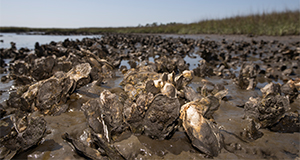Resumen
Nitrogen is natural and necessary, yet nitrogen levels above natural levels can cause algal blooms and eutrophication of coastal systems. The purpose of this document is to describe how oysters and oyster reefs remove nitrogen. This new 7-page publication of the UF/IFAS Department of Soil, Water, and Ecosystem Sciences is intended for policymakers, environmental organizations, and coastal residents who want to know about oysters' role in improving water quality through nitrogen removal. Written by Heather Donnelly, Ashley Smyth, Shirley Baker, Laura Reynolds, and Angela Collins.
https://edis.ifas.ufl.edu/ss711
Citas
Bricker, S. B., R. E. Grizzle, P. Trowbridge, J. M. Rose, J. G. Ferreira, K. Wellman, C. Zhu, E. Galimany, G. H. Wikfors, C. Saurel, R. L. Miller, J. Wands, R. Rheault, J. Steinberg, A. P. Jacob, E. D. Davenport, S. Ayvazian, M. Chintala, and M. A. Tedesco. 2019. “Bioextractive Removal of Nitrogen by Oysters in Great Bay Piscataqua River Estuary, New Hampshire, USA.” Estuaries and Coasts: Journal of the Estuarine Research Federation 43:23–38. https://doi.org/10.1007/s12237-019-00661-8
Carmichael, R. H., W. Walton, and H. Clark. 2012. “Bivalve-Enhanced Nitrogen Removal from Coastal Estuaries.” Canadian Journal of Fisheries and Aquatic Sciences 69 (7): 1131–1149. https://doi.org/10.1139/f2012-057
Cornwell, J., J. Rose, M. L. Kellogg, M. L. Luckenbach, S. B. Bricker, K. T. Paynter, C. M. Moore, M. Parker, L. P. Sanford, B. Wolinski, A. Lacatell, L. Fegly, and K. Hudson. 2016. Panel Recommendations on the Oyster BMP Nutrient and Suspended Sediment Reduction Effectiveness Determination Decision Framework and Nitrogen and Phosphorus Assimilation in Oyster Tissue Reduction Effectiveness for Oyster Aquaculture Practices.
Dame, R. F., J. D. Spurrier, and T. G. Wolaver. 1989. “Carbon, Nitrogen and Phosphorus Processing by an Oyster Reef.” Marine Ecology Progress Series 54:249–256. https://doi.org/10.3354/meps054249
Dame, R. F., R. G. Zingmark, and E. Haskin. 1984. “Oyster Reefs as Processors of Estuarine Materials.” Journal of Experimental Marine Biology and Ecology 83 (3): 239–247. https://doi.org/10.1016/S0022-0981(84)80003-9
Dvarskas, A., S. B. Bricker, G. H. Wikfors, J. J. Bohorquez, M. S. Dixon, and J. M. Rose. 2020. “Quantification and Valuation of Nitrogen Removal Services Provided by Commercial Shellfish Aquaculture at the Subwatershed Scale.” Environmental Science & Technology 54 (24): 16156–16165. https://doi.org/10.1021/acs.est.0c03066
Ehrich, M. K., and L. A. Harris. 2015. A Review of Existing Eastern Oyster Filtration Rate Models.” Ecological Modelling 297:201–212. https://doi.org/10.1016/j.ecolmodel.2014.11.023
Grabowski, J. H., R. D. Brumbaugh, R. F. Conrad, A. G. Keeler, J. J. Opaluch, C. H. Peterson, M. F. Piehler, S. P. Powers, and A. R. Smyth. 2012. “Economic Valuation of Ecosystem Services Provided by Oyster Reefs.” BioScience 62 (10): 900–909.
Gray, M. W., D. Pinton, A. Canestrelli, N. Dix, P. Marcum, D. Kimbro, and R. Grizzle. 2021. “Beyond Residence Time: Quantifying Factors That Drive the Spatially Explicit Filtration Services of an Abundant Native Oyster Population.” Estuaries and Coasts 45:1343–1360. https://doi.org/10.1007/s12237-021-01017-x
Kellogg, M. L., M. Brush, and J. Cornwell. 2018. An Updated Model for Estimating the TMDL-Related Benefits of Oyster Reef Restoration. https://www.conservationgateway.org/Documents/Harris_Creek_Model_and_Oyster_Reef_Restoration_Benefits.pdf
Kellogg, M. L., J. C. Cornwell, M. S. Owens, and K. T. Paynter. 2013. “Denitrification and Nutrient Assimilation on a Restored Oyster Reef.” Marine Ecology Progress Series 480:1–19. https://doi.org/10.3354/meps10331
Kellogg, M. L., A. R. Smyth, M. W. Luckenbach, R. H. Carmichael, B. L. Brown, J. C. Cornwell, M. F. Piehler, M. S. Owens, D. J. Dalrymple, and C. B. Higgins. 2014. “Use of Oysters to Mitigate Eutrophication in Coastal Waters.” Estuarine, Coastal and Shelf Science 151:156–168. https://doi.org/10.1016/j.ecss.2014.09.025
Kreeger, D. A., C. M. Gatenby, and P. W. Bergstrom. 2018. “Restoration Potential of Several Native Species of Bivalve Molluscs for Water Quality Improvement in Mid-Atlantic Watersheds.” Journal of Shellfish Research 37 (5): 1121–1157. https://doi.org/10.2983/035.037.0524
Lunstrum, A., K. McGlathery, and A. Smyth. 2018. “Oyster (Crassostrea virginica) Aquaculture Shifts Sediment Nitrogen Processes toward Mineralization over Denitrification.” Estuaries and Coasts 41:1130–1146. https://doi.org/10.1007/s12237-017-0327-x
Newell, R. 2004. “Ecosystem Influences of Natural and Cultivated Populations of Suspension-Feeding Bivalve Mollusks: A Review.” Journal of Shellfish Research 23:51–61.
Newell, R. I. E., J. C. Cornwell, and M. S. Owens. 2002. “Influence of Simulated Bivalve Biodeposition and Microphytobenthos on Sediment Nitrogen Dynamics: A Laboratory Study.” Limnology and Oceanography 47 (5): 1367–1379. https://doi.org/10.4319/lo.2002.47.5.1367
Piehler, M. F., and A. R. Smyth. 2011. “Habitat-Specific Distinctions in Estuarine Denitrification Affect Both Ecosystem Function and Services.” Ecosphere 2 (1): art12. https://doi.org/10.1890/ES10-00082.1
Ray, N. E., and R. W. Fulweiler. 2020. “Meta-analysis of Oyster Impacts on Coastal Biogeochemistry.” Nature Sustainability 4:261–269. https://doi.org/10.1038/s41893-020-00644-9
Ray, N. E., M. C. Henning, and R. W. Fulweiler. 2019. “Nitrogen and Phosphorus Cycling in the Digestive System and Shell Biofilm of the Eastern Oyster Crassostrea virginica.” Marine Ecology Progress Series 621:95–105. https://doi.org/10.3354/meps13007
Rose, J. M., J. S. Gosnell, S. Bricker, M. J. Brush, A. Colden, L. Harris, E. Karplus, A. Laferriere, N. H. Merrill, T. B. Murphy, J. Reitsma, J. Shockley, K. Stephenson, S. Theuerkauf, D. Ward, and R. W. Fulweiler. 2021. “Opportunities and Challenges for Including Oyster-Mediated Denitrification in Nitrogen Management Plans.” Estuaries and Coasts 44:2041–2055. https://doi.org/10.1007/s12237-021-00936-z
Smyth, A. R., N. R. Geraldi, and M. F. Piehler. 2013. “Oyster-Mediated Benthic-Pelagic Coupling Modifies Nitrogen Pools and Processes.” Marine Ecology Progress Series 493:23–30. https://doi.org/10.3354/meps10516
Smyth, A. R., N. R. Geraldi, S. P. Thompson, and M. F. Piehler. 2016. Biological Activity Exceeds Biogenic Structure in Influencing Sediment Nitrogen Cycling in Experimental Oyster Reefs.” Marine Ecology Progress Series 560:173–183. https://doi.org/10.3354/meps11922
Smyth, A. R., A. E. Murphy, I. C. Anderson, and B. Song. 2018. “Differential Effects of Bivalves on Sediment Nitrogen Cycling in a Shallow Coastal Bay.” Estuaries and Coasts 41:1147–1163. https://doi.org/10.1007/s12237-017-0344-9
Smyth, A. R., S. P. Thompson, K. N. Siporin, W. S. Gardner, M. J. McCarthy, and M. F. Piehler. 2013. “Assessing Nitrogen Dynamics throughout the Estuarine Landscape.” Estuaries and Coasts 36:44–55. https://doi.org/10.1007/s12237-012-9554-3
Vitousek, P. M., J. D. Aber, R. W. Howarth, G. E. Likens, P. A. Matson, D. W. Schindler, W. H. Schlesinger, and D. G. Tilman. 1997. “Human Alteration of the Global Nitrogen Cycle: Sources and Consequences.” Ecological Applications 7 (3): 737–750. https://doi.org/10.1890/1051-0761(1997)007[0737:HAOTGN]2.0.CO;2
Wade, T., and T. Borisova. 2022. “Water Quality Credit Trading: General Principles.” EDIS 2022 (1). https://doi.org/10.32473/edis-fe824-2022

